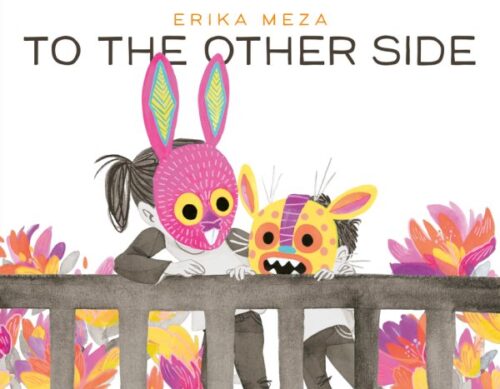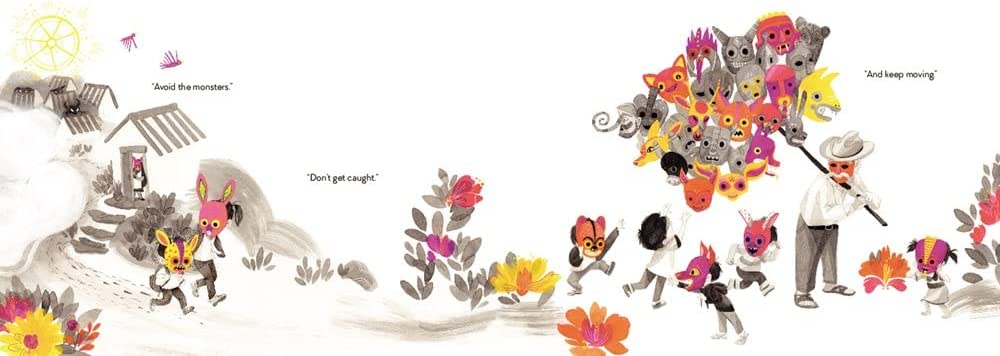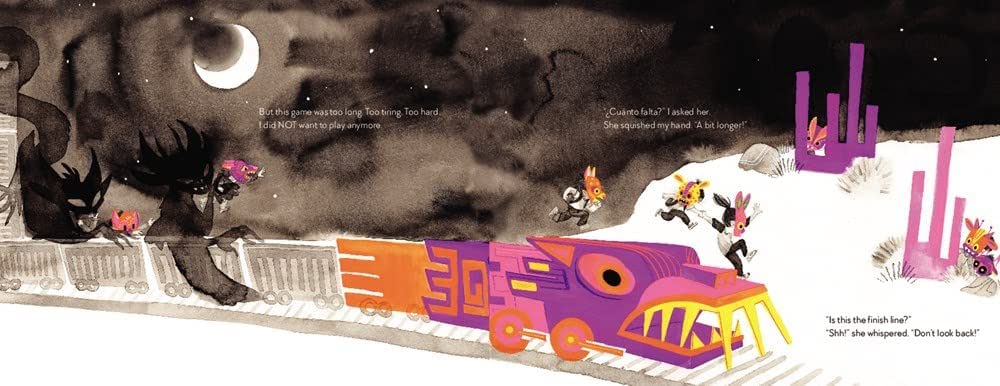Review of the Day: To the Other Side by Erika Meza

To the Other Side
By Erika Meza
Katherine Tegan Books (an imprint of Harper Collins)
$18.99
ISBN: 9780063073166
On shelves now
I don’t know how this book got made. I mean, I know the rudimentary basics behind it. I know how an author would write out a proposal and, if they were also an artist, draw some sketches. What I don’t know is how a person can look at a topic as impossible to encapsulate as child migrants moving across the U.S.-Mexico border and then know how to write a picture book on the subject. It dwarfs you, this subject matter. It engulfs. It’s too big to wrap your mind around, and yet, time after time, I watch as picture book creators work as hard as they can to find ways to tell stories that children will understand. Between Us and Abuela by Mitali Perkins took a stab at it. And there was My Journey With Papa by Deborah Mills and Alfredo Alva, sure. Still it feels too big to me. Too scary. And so when I read To the Other Side by Erika Meza, I was floored. With care and invention, she’s actually managed to tell a migrant story that is both literal and figurative, realistic and metaphorical, and does so with honesty and more than a bit of cleverness. As I said, I don’t know how this book got made, not because it shouldn’t have been made, but because I don’t know how you would even begin to put these pieces together. Pick your own favorites, but Meza’s latest is a beyond smart telling of a difficult (to say the least) topic.
It’s a game. You wear a mask. You avoid the monsters. You don’t get caught. And you keep moving as much as you can. Those are the rules. A young boy and his older sister, on their own, are traveling together. Sometimes they’re with other children. Sometimes they’re alone. They might travel by bus or by foot, over rivers or on the tops of trains. Sometimes they wait for long periods and sometimes they have to run for their lives. But always, always, they are together. And when they get to the end, long after the boy has realized that this journey is not actually a game, the future they find isn’t perfect, but there are things to love there.
ADVERTISEMENT
ADVERTISEMENT

I’ve only recently become a big fan of Erika Meza, though I’d vaguely registered her picture books over the years (As Brave as a Lion, My Two Border Towns, Mystery of the Monarchs, etc.). For me personally, though, it was her work on the 2022 title Mariana and Her Familia by Mónica Mancillas that particularly caught my eye. When I did read it, I was struck by Meza’s talent with faces. She has a gift for eyes and eyebrows as well as the positions of bodies and other ways of depicting emotion through physicality that is impossible to ignore. So I’m not dead to the irony of the fact that in To the Other Side, Meza hides most of the characters’ faces, for most of the book, behind brightly colored masks. If I was initially drawn by one aspect of her work, this book proves that Meza is more than just drawing pretty faces.
I’ve read this book multiple times. Over and over again. Each time, I notice new details. New elements I hadn’t before. One person I keep coming back to, over and over again, is the big sister in this book. Meza has carefully chosen the younger brother to be the narrator. His youth and optimism make him ideal for the job, but it’s the sister who’s the person you need to keep an eye on. She’s given the arduous task of not simply traveling across borders without a reliable adult, but also of doing so with a realistically rendered younger child. After a couple reads I noticed that her mask, which is of a rabbit, always has its eyes wide open. Even when her brother’s mask closes in his sleep, her eyes stay alert. At the end of the story, they’ve found safety and the boy is making a new friend. He’s happily tossed his mask to the ground, but his sister, who is never far from him, isn’t smiling yet. She keeps her mask in her hands, keeping it close so that if she had to, she could put it on again in a second. It’s the only time in the entire book when you see her face and you wonder how long it’ll be until she’s able to relinquish that mask entirely.

Getting away from the people a bit, I also noticed that Meza very subtly incorporates bars and gates into almost all the art here. The houses of the roofs where our main characters start, the wings of the birds (and the monsters), the slats of a raft, fronds on a palm, bridges, cactuses, railroad tracks, train cars, and more all replicate this same bar-like pattern. Even after the kids are in a safe space, a playground, the bars are in the see-saw, the seats of the swing, the monkey bars, and the steps of the slide. It’s so subtle, but what a clever way of making it clear that even when you’re running on the top of a train or sitting with marbles on the sidewalk, there are images and thoughts that will always remain on the periphery of your mind. Whether you want them to or not.
With all this being said, you might be under the understandable impression that with subject matter this dark, the book itself might come across as too scary or impenetrable for small children. And while I don’t think I’d be handing this to a preschooler anytime soon, for the most part I’d have to disagree. This is perfect for elementary school aged kids. Meza has taken several steps to balance the scary with the necessary, and it’s a wonder to watch her work. Our narrator sees much of the book as an adventure and a game, and even after he realizes that it isn’t, at the end of this story he’s teaching it to another child. And as I mentioned earlier, the colorful masks that the migrants wear cover up those incredible faces that Meza’s so good at drawing. It also covers up emotions that would wring your heart out if you could see them. Meza also has clues dropped in the corners that indicate difficulties, even when you don’t see them firsthand. Smoke rising from houses in the distance. Children’s shoes and backpacks abandoned in the desert without explanation. A single child with the only unpainted skull mask, indicating something deep and sad and unknowable. The end result is that you can read this on a child’s level, not really getting everything that’s going on here, as well as on an adult level, seeing everything but only if you really stop and look.

Since the press surrounding the U.S. separation policy came to light in 2018, I’ve paid closer attention to immigrant picture books that focus on migrants and refugees coming from the southern border. We’ve seen a number of different techniques over the years. Two White Rabbits by Jairo Buitrago, Pancho Rabbit and the Coyote by Duncan Tonatiuh, and Hear My Voice compiled by Warren Binford. Each book has a style and feel entirely different from its fellows but they all have in common a demand that we acknowledge people to be people. Meza writes in her Author’s Note at the end of the book, “Migrants and refugees are often portrayed as either heroes or villains; and yet, the children I was lucky to meet when working on this book were simply that: children.” Meza gives those children a voice in her backmatter, where she illustrates their words. And she gives them a voice in the picture book itself, where empathy is built and grown. I started off this review by saying I didn’t know how this book got made. Not when its subject matter is so huge and terrifying. But maybe I’ve something to learn from the older sister of this book. Maybe change can only come when someone tells us the right story.
On shelves now.
Source: Checked out copy from library.
Videos:
But don’t take my word for it. Here’s Erika Meza talking about the book herself:
Filed under: Best Books, Best Books of 2023, Reviews, Reviews 2023
About Betsy Bird
Betsy Bird is currently the Collection Development Manager of the Evanston Public Library system and a former Materials Specialist for New York Public Library. She has served on Newbery, written for Horn Book, and has done other lovely little things that she'd love to tell you about but that she's sure you'd find more interesting to hear of in person. Her opinions are her own and do not reflect those of EPL, SLJ, or any of the other acronyms you might be able to name. Follow her on Twitter: @fuseeight.
ADVERTISEMENT
ADVERTISEMENT
SLJ Blog Network
Should I make it holographic? Let’s make it holographic: a JUST ONE WAVE preorder gift for you
Magda, Intergalactic Chef: The Big Tournament | Exclusive Preview
Fifteen early Mock Newbery 2026 Contenders
When Book Bans are a Form of Discrimination, What is the Path to Justice?
Poetry Gateways, a guest post by Amy Brownlee
ADVERTISEMENT







